The 9 Best Smoke Detectors of 2023
Dotdash Meredith and Yahoo Inc. may earn commission or revenue on some items through the links below.
Plus, fire safety experts share what makes one smoke detector better than another.
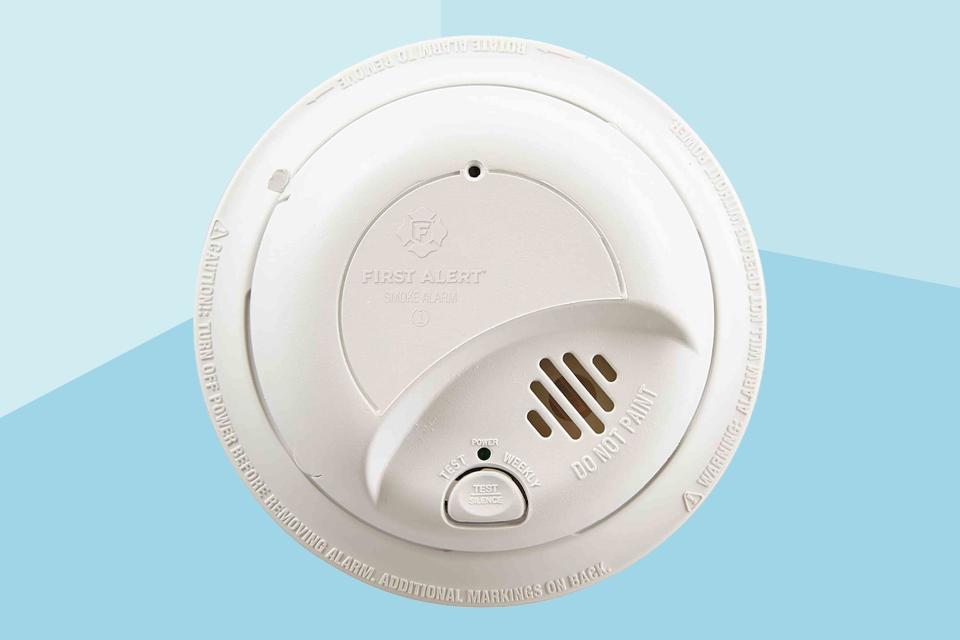
Real Simple / David Hattan
One of the most important items you can have in your home is a working smoke detector—and ideally not just one, but several, so you can ensure that your entire home is covered in the event of a fire.
Finding a smoke detector that you can trust to reliably do its job can be a difficult but necessary task. “Quality build in a smoke detector is everything,” says Patrick Andler of fire investigation firm Andler & Associates, Inc. “Buy the best quality one that you can afford.”
Philip Zaleski, executive director of the Illinois Fire Safety Alliance, suggests checking that whichever smoke detector you choose has been certified by a third party testing agency. “This should give residents confidence that the alarm will work when it’s most important,” he notes.
To find the best smoke alarms on the market, we researched many options and evaluated them on type, longevity, sensitivity, features, price, and more. We also received additional insight from Andler and Zaleski on how to choose the best smoke detector for your needs.
Best Overall Smoke Detector: First Alert SC9120B Hardwired Combination Smoke and Carbon Monoxide Alarm With Battery Backup
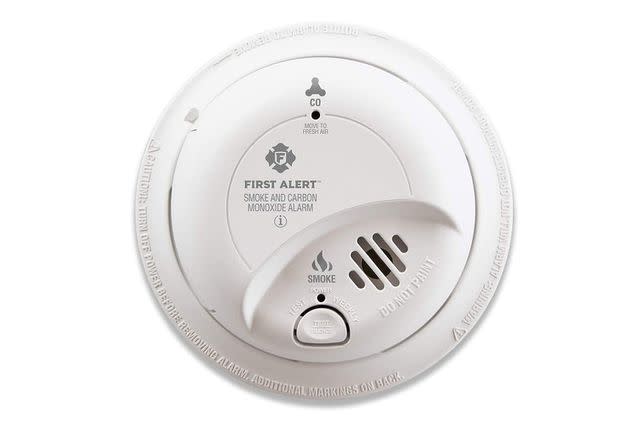
What Stands Out
It detects both smoke and carbon monoxide, and can be connected to other alarms in the home.
What Could Be Improved
It's hardwired, so it takes time to install (and probably isn't suited to renters).
For a highly reliable smoke detector that you can absolutely trust, look no further than this bestselling option from First Alert. It’s hardwired, but it comes with a battery backup in the event of a power failure. And if the battery runs low, it’ll let out a chirp, so you can fix the problem immediately. The alarm also acts as a carbon monoxide detector, making it even more of a helpful item to have in your home.
This smoke alarm is simple to use, with just one button for both testing and silencing and included mounting brackets to put it up on the wall. It features both electrochemical and ionization sensor technology to help it keenly detect smoke and carbon monoxide, and there are indicator lights (as well as a crystal-clear siren) that will alert you if there’s either in your home. And if you have First Alert detectors in other rooms, it’ll connect to them so that all the alarms will go off at once if there’s any danger.
Price at time of publish: $38
Sensor Type: Electrochemical, ionization | Carbon Monoxide Detector: Yes | Power Source: Hardwired with battery backup | Dimensions: 5.6 x 5.6 x 1.9 inches | Certifications: UL Listed | Warranty: 10 years
Best Budget Smoke Detector: Kidde Fire Sentry Battery-Operated Smoke Alarm i9040
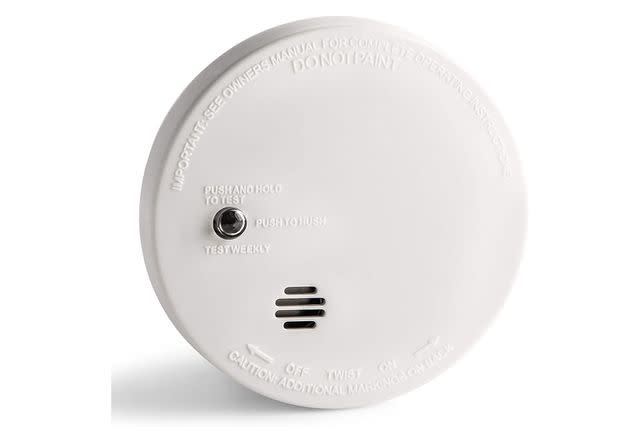
What Stands Out
It's very inconspicuous, so it blends into the wall easily.
What Could Be Improved
It doesn’t detect carbon monoxide.
If you’re not looking to spend so much on your smoke detector, consider this low-priced model from Kidde. It’s a simple yet effective smoke alarm that’s notable for being smaller and more lightweight than most other options, allowing it to blend in even more easily on your home’s walls.
This battery-operated smoke detector takes barely any time to install, and relies on an alkaline battery that’ll continue operating even if your home suffers a power outage. When it detects smoke or fire using its ionization sensor technology, it’ll emit a loud, unmissable alarm and set off its flashing red LED light, so you’ll immediately know to leave. The device also features a low battery indicator, as well as a test and hush button, the latter of which temporarily shuts down the alarm for eight minutes.
On the downside, this alarm doesn’t also act as a carbon monoxide detector, so it won’t be the best choice for everyone. But if you’re looking for a basic yet trustworthy smoke alarm, it could be the right fit for you.
Price at time of publish: $11
Sensor Type: Ionization | Carbon Monoxide Detector: No | Power Source: Batteries | Dimensions: 4 x 4 x 1.5 inches | Certifications: UL Listed | Warranty: 10 years
Best Battery-Powered Smoke Detector: Kidde Worry-Free Sealed Lithium Battery Power Smoke Alarm P3010L
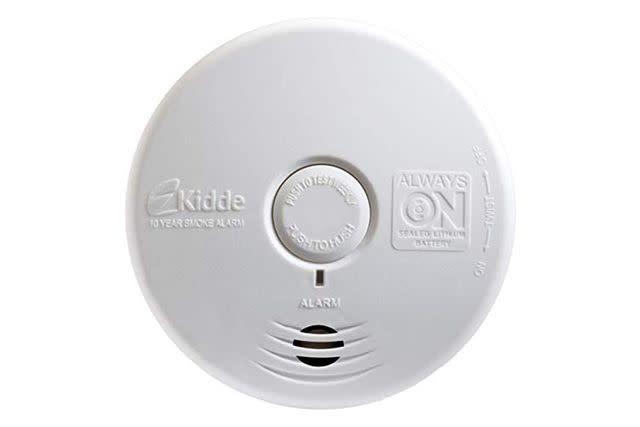
What Stands Out
It has a long battery life and is easy to install.
What Could Be Improved
It doesn’t have a carbon monoxide detector.
While the majority of smoke alarms out there are battery-powered, this model from Kidde stands out for its exceptionally long lithium battery life and easy battery installation. It should last for upwards of 10 years and require no battery changes during that time, and it will continue to work in the event of a power failure.
Additionally, this smoke alarm uses photoelectric sensors to quickly and effectively detect fire particles, and will emit a loud 85-decibel alarm if smoke or fire is found in your home. Helpfully, it has both a test and hush button (so you can turn it off immediately if there’s no danger present). It’s easy to install, too, thanks to the included mounting bracket, and features an LED light that will flash when testing, when in hush mode, and when the alarm sounds, to help ensure that you heed the call.
Unfortunately, this alarm doesn’t also act as a carbon monoxide detector, but that’s really its only downside. Otherwise, it’s a top-quality smoke alarm that you can trust to more than do its job if a fire is detected somewhere in your home.
Price at time of publish: $28
Sensor Type: Photoelectric | Carbon Monoxide Detector: No | Power Source: Batteries | Dimensions: 5.2 x 5.2 x 1.6 inches | Certifications: UL Listed | Warranty: 10 years
Best Smoke Detector With Carbon Monoxide Detector: First Alert ZCombo Wireless Smoke & Carbon Monoxide Alarm
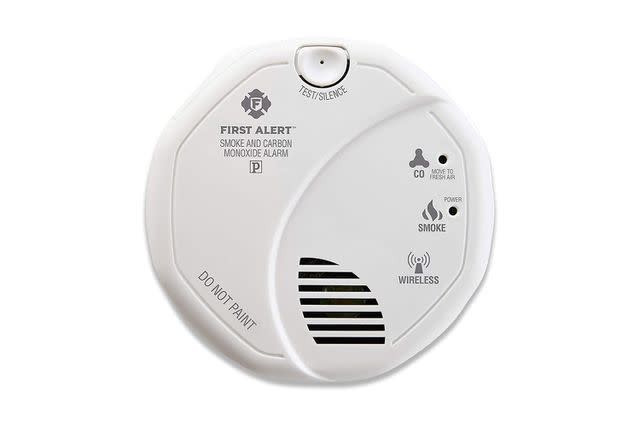
What Stands Out
It connects to Ring security systems so you can get real-time alerts on your phone.
What Could Be Improved
It doesn’t have flashing LED lights.
Rather than buying smoke detectors and carbon monoxide detectors separately, why not opt for a device that does both jobs in one, like this pick from First Alert? The battery-powered system is connected to Ring (as well as several other smart home systems), so you can get real-time notifications in the Ring app if the sensors have picked up any smoke or carbon monoxide in the house. Setting up the connection is as simple as it gets, as you just need to scan a QR code and connect the alarm to the hub.
This detector, which uses photoelectric smoke sensors, will alert you to smoke or a fire via an ultra-loud horn. It also has a single button for both testing and silencing the alarm, and you can install it on your wall easily via the mounting bracket and pins included in your purchase.
As far as negatives go, this alarm is on the pricier end of things, and it also doesn’t have any LED lights to help alert you when the sound is going off. Still, it’s a high-quality combo pick that’ll be a helpful addition to any home.
Price at time of publish: $47
Sensor Types: Electrochemical, photoelectric | Carbon Monoxide Detector: Yes | Power Source: Batteries | Dimensions: 5 x 5 x 2 inches | Certifications: UL Listed | Warranty: 7 years
Best Smoke Detector With Air Quality Monitor: Kidde Smoke + Carbon Monoxide Alarm with Indoor Air Quality Monitor
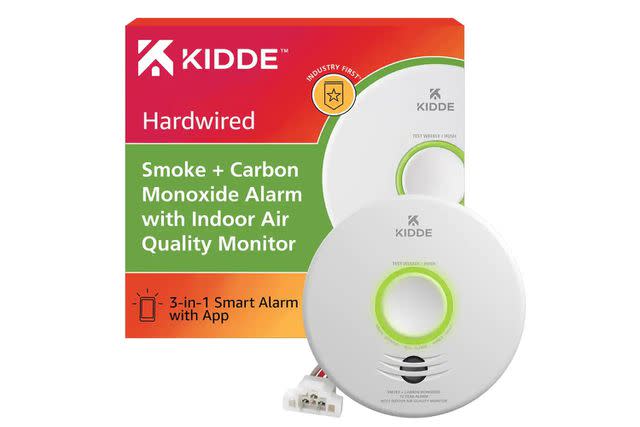
What Stands Out
It’s Wi-Fi-enabled and compatible with smart home devices.
What Could Be Improved
It’s quite pricey.
If you’re able and willing to spend a bit more on your smoke detector in order to benefit from special features, we’ve got the option for you. Made by Kidde, this alarm not only comes with a carbon monoxide detector, but also an air quality monitor that measures temperature, humidity, and chemical levels in your home. Even more, it connects to Wi-Fi and is compatible with smart devices like Google Home and Amazon Alexa, making it a seriously convenient device.
To set up the detector, just download the app and scan the QR code to access the instructions. You can also use the app to receive real-time notifications about the device, and check on the alarm’s status via voice commands through your smart home device. All of the alarms in your home can be connected, too, so they all activate together.
Additionally, it uses a photoelectric sensor to detect smoke and an electrochemical sensor to detect carbon monoxide, and will alert you to either’s presence with both an alarm and voice alerts. There’s also a hush feature so you can turn off the alarm if needed, as well as a test button. You can even set the device to send alerts to your loved ones when smoke is detected. Really, there’s nothing this alarm can’t do.
Price at time of publish: $109
Sensor Types: Photoelectric, electrochemical | Carbon Monoxide Detector: Yes | Power Source: Batteries | Dimensions: 5 x 5 x 2.4 inches | Certifications: UL Listed | Warranty: 10 years
Related: The 12 Best Air Purifiers of 2023, Tested and Reviewed
Best Smart Smoke Detector: Google Nest Protect Smoke & CO Alarm 2nd Generation

What Stands Out
You can connect it to your phone to receive alerts and control it remotely.
What Could Be Improved
It only has a 2-year warranty, which is disappointing considering the high price.
Ready for a super high-tech smoke alarm? Check out this option from Google, which is the first household smoke detector that can be hushed from your phone, without you having to place a hand on the alarm itself. It’ll also send you updates on the alarm’s battery life, so you don’t have to deal with an annoying chirp like with most smoke detectors.
This cool device uses a split-spectrum sensor (aka photoelectric enhanced with LED) to effectively detect smoke as well as an electrochemical sensor to detect carbon monoxide. And in addition to an audio alarm, it puts out voice alerts and alerts to your phone. It has a long battery life (up to a decade) and runs automatic tests on both the sensor and the speaker to make sure everything’s in good condition. Plus, it can be connected to all the other alarms in your home so you can be alerted to a threat no matter where you are.
As if that weren’t enough, the alarm lights up when someone walks underneath it, making it a great nightlight, and it’ll change color based on the type of alert needed (i.e. a heads up versus an emergency). As far as smart smoke alarms go, this device is truly top of the list.
Price at time of publish: $115
Sensor Types: Photoelectric, electrochemical | Carbon Monoxide Detector: Yes | Power Source: Batteries or hardwired | Dimensions: 5.3 x 5.3 x 1.6 inches | Certifications: UL Listed | Warranty: 2 years
Best Smoke Detector for Kitchen: Universal Security Instruments Sensing Plus AMI3051SB Multi-Criteria Smoke & Fire Alarm
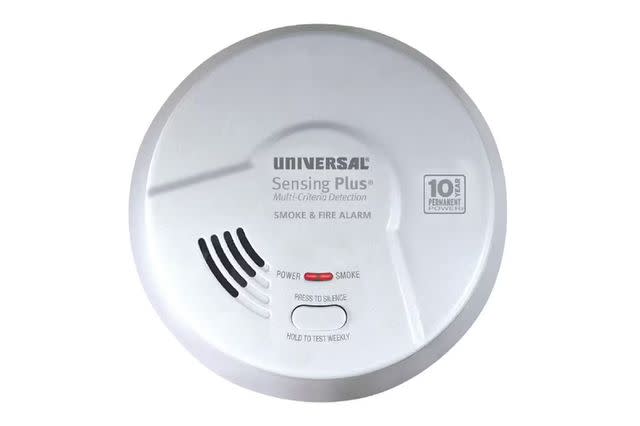
What Stands Out
It uses AI and two sensor types to detect smoke and flames.
What Could Be Improved
It’s not Wi-Fi enabled nor does it have a carbon monoxide detector.
The kitchen is one of the most important places in your home to have a smoke detector, and this option from Universal Security is a great choice. It’s a reliable, effective alarm that uses both photoelectric and ionization sensors (as well as AI) to detect smoke and flames, and its internal microprocessor ensures that the alarm won’t go off unnecessarily, such as from steam. Plus, it comes with a long-lasting battery that you won’t have to replace for at least a decade (and will still work even if there’s a power outage).
Other great aspects of this smoke detector include its single test and silencing button, its loud alarm, and its bright LED lights that’ll flash when the alarm goes off and when there’s any kind of power issue. The device will also give off a warning sound when the battery is running low, and you can switch it out easily via a quick activation pull tab.
Price-wise, this smoke detector is just about average, although it doesn’t feature a carbon monoxide detector. Overall, it’s a very solid pick for your kitchen, as well as any other rooms of your home in need of protection.
Price at time of publish: $27
Sensor Types: Photoelectric, ionization | Carbon Monoxide Detector: No | Power Source: Batteries | Dimensions: 5.6 x 5.6 x 1.8 inches | Certifications: UL Listed | Warranty: 10 years
Best Interconnected Smoke Detector: First Alert SA511CN2-3ST Interconnected Wireless Smoke Alarm with Voice & Location
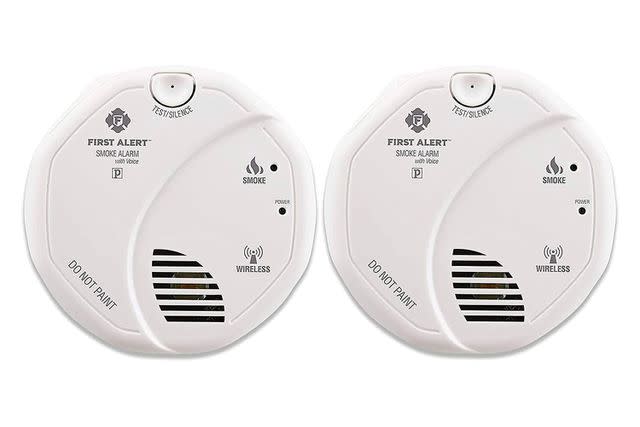
What Stands Out
It uses a voice alarm to tell you exactly where the smoke or fire is located in your home.
What Could Be Improved
It doesn’t have a carbon monoxide detector, LED lights, or smart home compatibility.
To ensure that you’ll be alerted immediately to the presence of fire or smoke no matter how far away you are in your home from the source, opt for interconnected smoke detectors like this two-pack from First Alert. When one alarm detects smoke or fire, it’ll automatically enable all the other alarms in your home so that you’ll be able to react instantly.
This battery-powered alarm doesn’t just emit a siren when it’s detected danger via its photoelectric sensors, but a voice alarm that’ll tell you exactly where in your home the danger is, helping you deal with the problem even faster. You can choose from 11 programmable locations to make sure your entire home is covered, and connect the alarm to up to 18 others throughout your home.
Additionally, this alarm features a single test/silencing button, a timer that’ll alert you when the battery is running low, and a feature that minimizes the chance of false alarms from steam. It’s easy to install, too, making it a supremely helpful choice all around, particularly for people with large homes with many rooms.
Price at time of publish: $75 for 2-pack
Sensor Types: Photoelectric | Carbon Monoxide Detector: No | Power Source: Batteries | Dimensions: 5 x 5 x 2 inches | Certifications: UL Listed | Warranty: 10 years
Best Dual-Sensor Smoke Detector: Kidde Dual Sensor AC Hardwired Interconnect Smoke Alarm Pi2010

What Stands Out
It’s more sensitive to both visible and invisible particles than most alarms.
What Could Be Improved
It’s hardwired, so it requires more work to install.
While smoke alarms that just use either photoelectric or ionization sensors are perfectly effective, a detector that uses both offers even more sensitivity when it comes to finding smoke or flames. We love this model from Kidde, which makes use of both of its sensors to quickly detect both visible and invisible particles to alert you to danger as soon as possible.
This smoke detector is hardwired but comes with a battery backup in case of a power outage, and it can work either as an individual alarm or interconnect with up to 24 other alarms around your home. It features a hush button so you can silence the alarm immediately if needed, and a power harness to help with the installation process. It also has a voice alarm in addition to the siren, and a safety light so you can see where you’re going in the event of a fire at nighttime.
Because this is a hardwired alarm and requires more time and effort to set up, it may not be everyone’s first choice, but if you’re okay with that process, you’ll be glad you picked this highly effective device.
Price at time of publish: $34
Sensor Types: Photoelectric, ionization | Carbon Monoxide Detector: No | Power Source: Hardwired with battery backup | Dimensions: 5.8 x 5.8 x 1.8 inches | Certifications: UL Listed | Warranty: 10 years
Final Verdict
Our best overall pick is the First Alert SC9120B Hardwired Smoke and Carbon Monoxide Alarm, a superbly reliable and effective double-duty device. For a lower-priced alternative, though, consider the Kidde Fire Sentry Battery-Operated Smoke Alarm, which offers fewer features but still offers a long 10-year battery life and warranty.
How to Shop for Smoke Detectors Like a Pro
Sensor Type
Smoke detectors typically feature either ionization sensors or photoelectric sensors (with some models offering both options). Ionization smoke alarms “detect flaming fires, where photoelectric alarms can detect smoldering fires,” says Philip Zaleski, executive director of the Illinois Fire Safety Alliance.
Alarms with ionization sensors use electrodes to conduct currents through ionized air, and when smoke particles enter that airspace, they trigger the alarm. As such, these types of alarms are better than photoelectric alarms at detecting tinier and less visible fire particles.
Photoelectric alarms, meanwhile, use light to detect smoke, as smoke particles that come into their light beams will cause the light to hit the sensor and trip the alarm. These kinds of alarms are great for catching larger fire particles.
The most sensitive alarms will have both types of sensors, but tend to be pricier because of that. Yet according to Zaleski, that might change soon. “There are new national standards that should be taking place soon that will require new sensors to manage all of the types of smoke, and when that happens, there will be no confusion or debate on which alarm to purchase for your home,” he says.
Finally, electrochemical sensors are used to detect carbon monoxide by using electrodes immersed in a chemical solution.
Power Source
Most smoke detectors are battery-operated, and typically require a few AA batteries to operate (which you may have to buy separately). These alarms usually last for at least 10 years, and you can turn the sound off simply by taking out the batteries.
Some detectors, however, are hardwired, meaning they are wired directly into your home’s electrical system, and thus require more time and effort to install. These kinds of alarms will usually come with battery backup, just in case there’s a power outage, but because they’re connected to your home’s electricity, you have to turn them off in order to stop the sound, which can be tricky. Still, a benefit is that you never have to worry about replacing batteries and the smoke detector losing power.
Certifications
Certifications aren't just a "good to have"—in most states, they're actually law. When looking for certifications, the biggest name is UL, which is a third-party certification company that's been setting standards for smoke alarms for over 40 years. A UL certification is law in most states, and homes without UL Listed fire detectors will not pass home inspections. With that in mind, all of the products are on our list are UL Listed.
Sensitivity
Smoke alarms that use both photoelectric or ionization sensors tend to be especially sensitive when it comes to detecting smoke or flames. Still, you want to make sure that your alarm isn’t going off every time there’s steam in the house, which is why it can be smart to opt for detectors that come with internal microprocessors that are designed to pick up on steam but understand it’s not a threat and don’t set off the alarm.
Questions You Might Ask
How many smoke detectors should you have?
“Ideally, there should be at least one smoke alarm on every level of the home, including the basement, outside each sleeping area (within 15 feet of that area), and inside each bedroom,” says Zaleski. Patrick Andler of fire investigation firm Andler & Associates, Inc. adds that one should also be placed right outside the kitchen area so that it is close enough to instantly detect smoke or flames from cooking, but not directly over an area where steam may be present.
How long will a smoke detector last?
A good smoke alarm should last at least 10 years, says Zaleski. “After that, manufacturers cannot guarantee that the sensor in the unit will work properly, even if you press the ‘Test’ button and it beeps,” he explains.
How often should you replace a smoke detector?
Making sure your smoke detector is in fact working is an important step on your home safety checklist. If it’s been at least 10 years since the alarm was manufactured (you can find this on the back of the alarm), it’s definitely time for a replacement. But even before that time comes, “you should also be testing your smoke alarm monthly,” says Zaleski. “You simply press the ‘Test’ button and if it beeps, you know the battery is still functioning.”
Do you need both photoelectric and ionization smoke detectors in your home?
Many professionals recommend that you have both photoelectric and ionization smoke detectors in your home, because “you can never have enough protection,” says Andler. “Seconds count in a home fire.” Smoke detectors that feature just one of those sensors are still absolutely useful tools, but for ultimate coverage, opt for a model that comes with both to ensure that it’s picking up on all types and sizes of smoke and fire particles in the air.
Take Our Word for It
This article was written by Rachel Simon, a writer for Real Simple, Better Homes & Gardens, The New York Times, and many other publications. To write this article, she researched a wide variety of smoke detectors and judged them based on type, longevity, sensitivity, features, price, and more. She also spoke to Patrick Andler of fire investigation firm Andler & Associates, Inc. and Philip Zaleski, executive director of the Illinois Fire Safety Alliance.
For more Real Simple news, make sure to sign up for our newsletter!
Read the original article on Real Simple.

